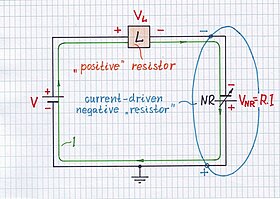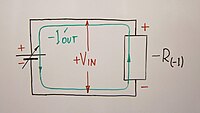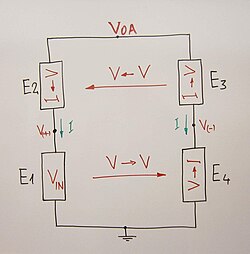Circuit Idea/Negative Impedance Converter
Circuit idea: Inverting the impedance by inverting either the voltage or current
Negative impedance converters (NICs) are ones of the most interesting, odd, "mystic" and still unexplained electronic circuits... a real nightmare for students... and their teachers:) It is hard to believe but still there are not "human-friendly" explanations of these legendary circuits (even the famous Mr. Horovitz has mentioned but not explained the NIC in his bestseller The Art of Electronics, page 251; instead, he has afforded this opportunity to his students:). For us, "circuit thinkers", the understanding of this clever circuit (in its two versions) would be crucial for understanding the very phenomenon of negative impedance.

What is negative impedance converter?
[edit | edit source]

It is just an op-amp implementation of a true negative resistor. But what is a true negative resistor? It is the opposite "element" of the ordinary "positive" resistor; it is a circuit adding (injecting) the same energy that the equivalent "positive" resistor would dissipate. So, it is nothing else than a source... but this is not the ordinary constant source; it is a "self-varying" (dynamic) source. And as there are two kinds of sources (in contrast with the only one kind of "positive" resistor), there are two kinds of true negative resistors (S-shaped and N-shaped). Accordingly, there are two kinds of their op-amp implementations (VNIC and INIC) as well. First (Fig. 1a), a NIC can behave as a dynamic voltage source producing voltage that is proportional to the current passing through it (named voltage inversion NIC or VNIC) or (Fig. 1b) as a dynamic current source producing current that is proportional to the voltage across it (named current inversion NIC or INIC). You can consider the VNIC as a 1-port current-to-voltage (really "to voltage", not "to voltage drop"!) converter and INIC - as a 1-port voltage-to-current converter.
How to create negative impedance converters
[edit | edit source]The amazing feature of negative impedance is to neutralize the equivalent "positive" impedance: connecting an S-shaped negative impedance element in series witn the equivalent "positive" impedance element (Fig. 1a) gives zero total impedance; connecting an N-shaped negative impedance element in parallel to the equivalent positive impedance element (Fig. 1b) gives infinite total impedance. So these elements are extremely useful electronic devices (circuits). Unfortunately, they do not exist in nature; there are only ordinary passive elements with "positive" impedance (resistors, capacitors and inductors). Then how do we create them?
The idea is simple but powerful - we can make negative impedance by inverting some initial positive impedance. Thus the original positive elements will serve as shaping (forming, moulding, modeling) elements giving the respective I-V functional relationship for creating "mirror" negative elements. But how do we invert the positive impedance? In the simplest case, how do we invert the positive resistance?
The answer is simple if only we know the Ohm's law (how wonderful it sounds:) As everyone knows, it presents the resistance as a ratio between the voltage and current (R = V/I); so when the two variables are positive, the resistance is positive as well. To make negative resistance, we have to invert one of them - either the voltage or the current.

Inverting the voltage polarity
[edit | edit source]In the case of the S-shaped negative resistance RS, we invert the voltage (RS = -V/I = -R). This means that if we pass current through the S-shaped negative resistor R(-V) - Fig. 2a, the input terminal becomes negative (instead positive as in the case of the ordinary "positive" resistor). That is why, circuits implementing this technique are named voltage-inversion negative impedance converters (VNIC). Note the power is also inverted (PS = -V.I = -P).

Inverting the current direction
[edit | edit source]In the case of the N-shaped negative resistance RN, we invert the current (RN = V/-I = -R). This means that if we apply positive voltage across the N-shaped negative resistor R(-I) - Fig. 2b, the current goes out of the negative resistor and enters the positive terminal of the voltage source (instead to leave the positive terminal of the voltage source and to enter the negative resistor as in the case of the ordinary "positive" resistor). That is why, circuits implementing this technique are named current-inversion negative impedance converters (INIC). Note the power is also inverted (PN = V.-I = -P).
How to implement conceptually the resistance inversion
[edit | edit source]Now, we have only to answer the questions: "How do we invert the voltage?", "How do we invert the current?" and generally, "How do we invert an electrical quantity?" To do that, we need more than Ohm's law... We can see the solution around us when we invert some (usually "bad") quantity by adding a bigger opposite ("good") quantity.

V-inverted resistor
[edit | edit source]If we pass an input current IIN through a positive resistor R, it will produce a voltage drop VR = IIN.R across the resistor (Ohm's law). We can use this voltage to drive an additional "helping" voltage source VH to produce the inverted voltage (Fig. 3a, at the right side). But as the voltage drop VR subtracts from this voltage, the latter has to be two times higher than VR (VH = -2VR). Thus the resulting voltage VOUT = VR - VH = VR - 2VR = -VR across the whole "inverted resistor" will be the same as the initial voltage across the resistor... but inverted...
So, we may convert (invert) the "bad voltage drop" across an initial positive resistor into a "good voltage" across a new negative resistor by adding a two times higher negative voltage (connecting in series a doubling variable voltage source).
But an interesting question arises now... In this arrangements, actually we have connected two elements in series - a "positive" resistor and a negative "resistor" (the varying voltage source on the right). The negative element dominates and the resulting resistance is negative. The question is, "Why have we connected two kinds of resistance - positive and negative, after we ultimately want only negative? Why do not we just use the negative resistance? For what we need the positive resistance? Why do we need to "mix" negative with positive resistance to obtain again negative resistance?

I-inverted resistor
[edit | edit source]Dually, if we apply an input voltage VIN across a positive resistor R, a current IR = VIN/R will begin flowing through the resistor (Ohm's law). Now we can invert (reverse) the current direction by connecting an additional "opposing" voltage source VO in series, which voltage is two times higher than the input voltage. As a result, the same but opposite current IOUT = (VIN - VO)/R = (VIN - 2VIN)/R = VIN/R - 2VIN/R = IR - 2IR = -IR will flow through the resistor, and it enters back in the input source.
So the trick here is to add two times bigger reverse current to the initial direct current with the purpose to create a "negative" current.
How to realize NICs by fixed gain amplifiers
[edit | edit source]
Voltage-inversion fixed-gain NIC
[edit | edit source]We can realize the ideas above first by using fixed gain amplifiers. We can build a VNIC by a differential "inverting" amplifier (why?) having a gain of 2 if we connect its input in parallel and its output - in series to the resistor... Thus the amplifier begins acting as the doubling voltage source above.

Current-inversion fixed-gain NIC
[edit | edit source]... and an INIC - by a non-inverting amplifier having a gain of 2.
How to realize NICs by op-amps
[edit | edit source]
Voltage-inversion op-amp NIC
[edit | edit source]But nowadays we use op-amps to realize precise fixed-gain amplifiers. So, we can build a voltage-inversion op-amp NIC (VNIC) by making the little exotic "inverting" amplifier below - K = (R1+ R2)/R2...

Current-inversion op-amp NIC
[edit | edit source]... and a current-inversion op-amp NIC (INIC) by making the classic non-inverting amplifier below - K = (R1+ R2)/R1...
Presenting the op-amp NIC as a bridge
[edit | edit source]Voltage-inversion op-amp bridge NIC
[edit | edit source]Conceptual bridge VNIC
[edit | edit source]
Op-amp bridge VNIC
[edit | edit source]
Functional bridge VNIC
[edit | edit source]
What is the element to be V-inverted?
[edit | edit source]
Current-inversion op-amp bridge NIC
[edit | edit source]Conceptual bridge INIC
[edit | edit source]
Op-amp bridge INIC
[edit | edit source]
The op-amp keeps up the voltage drop VE across RE equal to the input voltage VIN (the op-amp acts as a voltage-to-voltage converter or voltage follower) by passing a current IE = VE/RE = VIN/RE through the right resistor RR (so RE acts as a voltage-to-current converter). The current IE creates a voltage drop VRR = IE.RR across RR (so RE acts as a current-to-voltage converter). The op-amp keeps up the voltage drop across the left resistor RL equal to the voltage drop across the right resistor RR (the op-amp acts as another voltage-to-voltage converter or voltage follower) by passing a current IOUT = VRL/RL = VRR/RL = (IE.RR)/RL = ((VIN/RE).RR)/RL through the input source. So, the input resistance is -RL.RE/RR.
If RL = RR = R (the usual case), the circuit injects the same current IOUT = -IE that would be drawn by the resistor RE if it was connected directly to the input source. So, it behaves as a "negative resistor" RE having the same voltage as the positive RE but with an inverted current; thus the name of the circuit - "negative impedance converter with current inversion" (INIC). The circuit "inverts" every positive/negative element (resistor, capacitor or inductor) connected in the place of the resistor RE to the "opposite" negative/positive element with equivalent impedance; it is just a "current inverter" (actually, the very INIC consists of the two resistors RL and RR, and the op-amp). According to this explanation, the current IOUT enters the input source when it produces a positive voltage.
Functional bridge INIC
[edit | edit source]
What is the element to be I-inverted?
[edit | edit source]
See also
[edit | edit source]Investigating the linear mode of negative impedance converters with voltage inversion
Investigating the linear mode of negative impedance converters with current inversion
Negative impedance converter considers NIC with current inversion (INIC).
References
[edit | edit source]
External links
[edit | edit source]is a genuine source from 50's
- Understanding negative impedance converters (VNIC) - reveals in three consecutive steps the basic idea behind negative impedance converters with voltage inversion (VNIC).
- Negative Resistance Revived - condensed version of article originally published in Amateur Radio, November 1995.
- Negative-resistance circuits - nice material from Answers.com.
- Handbook of operational amplifier active RC networks - a formal but well-written electronic book.
- Introduction to Negative Impedance Converters - A well structured intro on AllAboutCircuits
